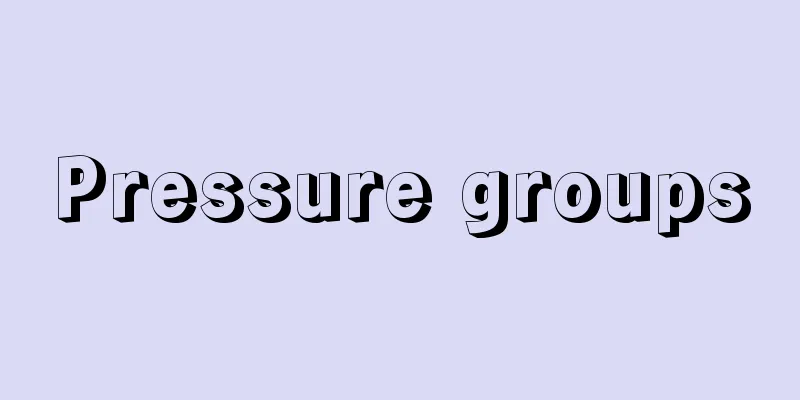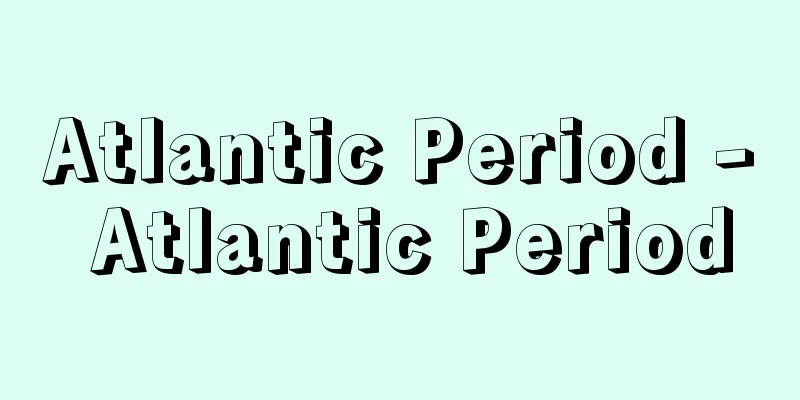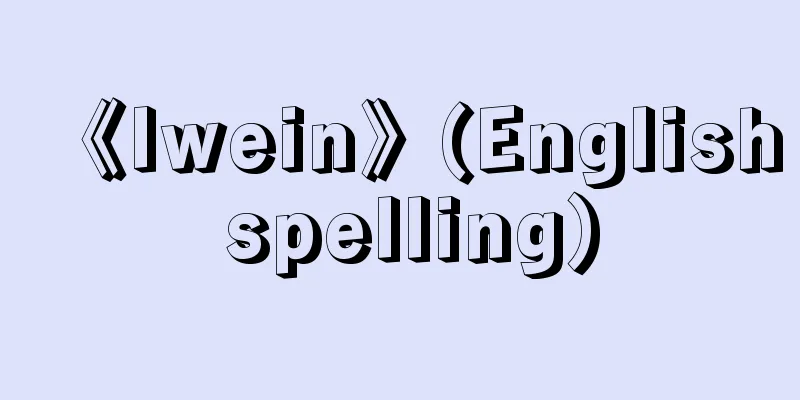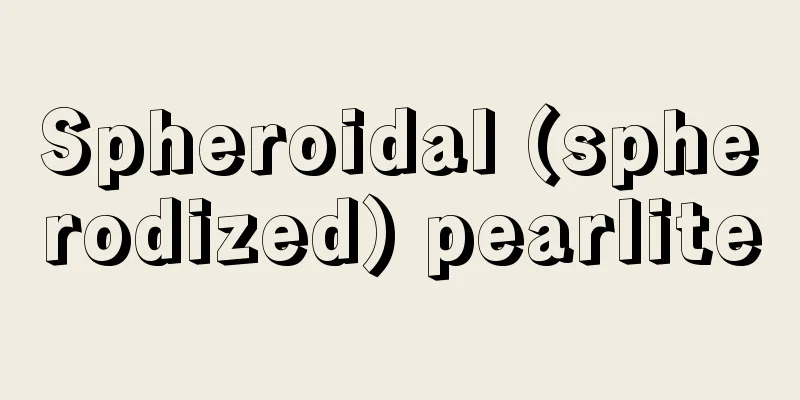Pressure groups

|
It refers to a group that attempts to exert influence in a more or less organized way on government in the broad sense (parliament at any level, executive branch, political party, etc.) or on the political process (policy formation process, execution process, public opinion, etc.) in order to achieve its own goals. It is distinguished from political parties in that it does not directly aim to gain power or govern the country. Because the term "pressure group" has a negative connotation, in recent years neutral terms such as "political interest group" and "lobby" are often used. [Taguchi Fukuji] TypeUntil the 1950s, pressure groups were understood as groups that aimed to realize "special interests," especially economic and professional special interests. In the United States, where pressure groups developed the earliest, examples include management organizations such as the National Association of Manufacturers (NAM), labor unions such as the American Federation of Labor-Congress of Industrial Unions (AFL-CIO), agricultural organizations such as the National Farmers Union (NFU, Democratic Party) and the American Farm Land Bureau Federation (AFBF, Republican Party), the American Legion (Veterans Association), the American Medical Association, and the National Rifle Association (NRA). However, from the late 1960s onwards, "public interest groups" and "countervailing interest groups" emerged that lobby government and politics to realize "public interests" or "counter interests" that are different from or counter to these special interest groups. Taking the United States as an example again, there are political reform, environmental protection, and consumer groups such as Common Cause, which was founded in 1970, the organizations of Ralph Nader and others, the Consumers Federation of America, and the Consumers Union (incidentally, peace groups such as the British nuclear disarmament organization CND could also be placed in this category). In addition, there are groups for the elderly, groups for welfare pensioners, and groups for the physically and mentally disabled. In short, while traditional pressure groups are oriented toward specific economic interests, public interest groups and counter-interest groups are oriented toward the interests of the general public or the interests of the socially vulnerable, and have emerged as a counterforce to the former. Some scholars also call "public interest groups" "attitude groups" or "promotional groups." In Japan, organizations that belong to the category of traditional pressure groups include the Japan Business Federation (Keidanren, founded in 2002 by merging the Japan Federation of Employers' Associations and the Japan Business Federation), the Japan Association of Corporate Executives (founded in 1946), the Japan Chamber of Commerce and Industry (Nissho, founded in 1921) that existed before the Second World War, the Japanese Trade Union Confederation (Rengo, founded in 1989 by merging the General Council of Japanese Trade Unions and the All Japan Labour Federation), and in the agricultural sector, agricultural cooperatives (Nokyo, founded in 1947).As consumer organizations, consumer cooperatives (Co-ops) loosely organize over 10 million people through purchasing.Other examples include the Japan Medical Association, the Japan Dental Association, six local associations (National Association of Governors, Mayors and Town and Village Mayors, National Association of Chairpersons of Prefectural Assemblies, City Council Chairpersons and Town and Village Council Chairpersons), and various trade associations, while promotional groups include various peace movement groups, environmental protection groups, and consumer groups. [Taguchi Fukuji] Background to the riseAs mentioned above, the pressure group phenomenon has developed particularly in the United States from an early stage, and national pressure groups began to appear especially from the middle of the 19th century. The reasons for this include, as socio-economic factors, the conflicts of regional interests resulting from the geographical vastness of the United States, the conflicts of interests based on racial and religious diversity, and the conflicts of economic interests, as well as, as political factors, the state of politics that respects public opinion in the country, the pluralistic and complex government structure based on federalism and the separation of powers, the characteristics of American political parties, especially the fragility of party discipline and the weakness of national party leadership. However, after the Second World War, it became clear that the pressure group phenomenon was not unique to the United States, but was a phenomenon commonly recognized in developed countries at the latest since the beginning of the 20th century. The conditions or background for the rise of pressure groups in various countries since the beginning of the 20th century can be attributed to two interrelated factors: One is the polarization of classes that accompanies the advancement of capitalism, and the progression of hierarchical decomposition and functional differentiation within each class. These classes, strata, and functions often organize themselves in a chain reaction to protect and realize their respective interests (the "group eruption" phenomenon). In this case, the development of communication, transportation, and other technologies that accompany the advancement of capitalism makes it easier to organize groups and to form huge pressure groups with large-scale, bureaucratic structures. Secondly, the advancement of capitalism brings about a phenomenon known as the expansion of state functions and the strengthening of executive power. In particular, after the Second World War, the state went beyond mere measures to deal with depressions and wartime mobilization, and aimed to plan the long-term stability and growth of capitalism, and its economic and social control functions became comprehensive, permanent, and structural (socialization of government activity). Thus, in order to defend and realize their own interests, all professional and other interest groups inevitably became interested in the political process and had to constantly work on it (politicization of society). Furthermore, such comprehensive government intervention made various interests that had previously remained latent visible and organized, driving them into pressure activities. Furthermore, the reasons often given for the rise of pressure groups, such as inadequacies in regional representation or the loss of the intermediary function of political parties, are often actually the result of the reasons mentioned above. [Taguchi Fukuji] Contemporary politics and pressure groupsThe way pressure groups operate in each country varies depending on the structure of the government, the nature of political parties, and the characteristics of the political culture. For example, in the United States, which has a decentralized governance structure and a two-party system with loose party discipline, pressure groups' "points of access" are widely dispersed among both houses of parliament and their committees, the president and the executive branch, state and local legislatures and executive branches, and public opinion. In contrast, in the United Kingdom, which has a parliamentary cabinet system and a two-party system with strong party discipline, the main "point of access" is set at the centralized party cabinet = bureaucracy, and access to Parliament is only of secondary importance. However, even in the United Kingdom, in addition to the traditional pressure activities on the legislative branch, pressure activities on the executive branch (administrative lobbying) are becoming increasingly important. In terms of methods of pressure, in addition to direct lobbying, in which lobbyists make direct contact with government officials, politicians, and influential party members, indirect lobbying or grassroots lobbying is becoming more common, in which lobbyists engage in public activities aimed at shaping public opinion in a way that is favorable to their own organization, and indirect lobbying involves organizing requests and protests from ordinary voters to politicians and others via letters and telegrams. As for how political culture affects the relationships and behavior of pressure groups, in countries with a generally homogeneous, secular culture and a highly differentiated and stable political role structure, such as Anglo-Saxon countries, pressure groups do not have very antagonistic relationships and rarely take "extreme" actions that go beyond the framework of the system, whereas in countries with less homogeneous political cultures and less stable role structures, there is mutual penetration of certain political parties and pressure groups, sharp conflict between affiliated political parties and pressure groups, and the adoption of "extreme" measures by some pressure groups. Problems with "pressure politics" include: [Taguchi Fukuji] "Pressure Groups in Japan," edited by the Japanese Political Science Association (1960, Iwanami Shoten)" ▽ "Pressure Group Theory," by Kamibayashi Teiichi (1963, Yuhikaku)" ▽ "The Political Function of Social Groups," by Taguchi Fukuji (1969, Miraisha)" ▽ "Study of American Pressure Groups," by Uchida Mitsuru (1980, San'ichi Shobo)" ▽ "Pressure Groups in Postwar Japan," by Muramatsu Michio, Ito Mitsutoshi, and Tsujinaka Yutaka (1986, Toyo Keizai Shinposha)" ▽ "Interest Groups," by Tsujinaka Yutaka (1988, University of Tokyo Press)" ▽ "The Changing Politics of American Pressure," by Uchida Mitsuru (1995, Sanmine Shobo) [References] | | | | | | | | Medical Association| | | | |Source: Shogakukan Encyclopedia Nipponica About Encyclopedia Nipponica Information | Legend |
|
自らの目的を実現するために、広義の政府(各級の議会、行政府、政党など)ないし政治過程(政策形成過程、執行過程、世論など)に対して、多少とも組織的な仕方で影響力を行使しようとする集団をいう。それは政権の獲得と国の統治を直接には目ざさないという点で、政党とは区別される。「圧力団体」ということばの語感が悪いため、近年は「政治的利益集団」「ロビー」lobbyなどの中立的語感をもつ用語が使用されることが多い。 [田口富久治] 類型1950年代ごろまでは、圧力団体は「特殊利益」、とくに経済的、職能的な特殊利益の実現を目ざす集団として理解されてきた。それが歴史的にもっとも早くから発達したアメリカ合衆国の例をとれば、全国製造業者協会(NAM)などの経営者団体、アメリカ労働総同盟・産業別組合会議(AFL-CIO)に代表される労働組合、全国農民同盟(NFU。民主党系)やアメリカ農地局総同盟(AFBF。共和党系)などの農業団体、アメリカン・リージョン(在郷軍人会)、アメリカ医師会、全米ライフル協会(NRA)などがそれにあたる。しかし1960年代末以降になると、このような特殊利益団体とは異質の、あるいはこれらに対抗する「公共利益」や「対抗利益」の実現を目ざして政府と政治に働きかける「公共利益団体」public interest groupsや「対抗利益団体」countervailing interest groupsが台頭してきた。ふたたびアメリカを例にとると、1970年に設立されたコモンコーズ、ラルフ・ネーダーらの諸組織、アメリカ消費者連盟、消費者同盟など、政治改革、環境保護、消費者の諸団体がある(ちなみにイギリスの核軍備撤廃運動組織CNDなどの平和団体もこのカテゴリーに入れることができよう)。さらに、高齢者団体、福祉年金受給者団体、心身障害者団体などもあげられよう。要するに、伝統的な圧力団体が特殊経済利益志向型であるのに対し、公共利益団体や対抗利益団体は、公衆全体の利益あるいは社会的弱者の利益を志向し、前者に対する対抗力として登場してきたものである。なお、「公共利益団体」を「態度集団」「促進団体」promotional groupとよんでいる学者もある。 日本の場合においても、伝統的圧力団体のカテゴリーに属するものとして、企業分野では日本経済団体連合会(経団連。2002年にそれまでの日本経営者団体連盟と経済団体連合会とを統合して創設)、経済同友会(1946年創設)、第二次世界大戦前からの日本商工会議所(日商。1921年創設)、労働分野では日本労働組合総連合会(連合。1989年にそれまでの日本労働組合総評議会、全日本労働総同盟などを統合して創設)など、農業分野では農業協同組合(農協。1947年創設)、消費者の組織としては生活協同組合(生協)が購買を通じて1000万人以上を緩やかに組織している。そのほか、日本医師会、日本歯科医師会、地方六団体(全国知事会・市長会・町村長会、全国都道府県議会議長会・市議会議長会・町村議会議長会)、各種業者団体などがあげられるし、促進団体に属するものとしては、各種の平和運動団体、環境保護団体、消費者団体などがある。 [田口富久治] 台頭の背景すでに触れたように、圧力団体現象はとりわけアメリカにおいて早くから顕著に発展してきた現象であって、とくに19世紀の中ごろ以降に全国的基盤にたつ圧力団体が輩出した。その理由として、社会・経済的要因としては、アメリカの地理的広大さに由来する地域的利益の対立、人種的・宗教的多様性に基づく利益の対立、経済的利益の対立、政治的要因としては、この国における世論尊重の政治のあり方、連邦制および権力分立制などに基づく政府構造の多元性・複雑性、アメリカの政党の特質、とくに党規律の脆弱(ぜいじゃく)性、全国的政党リーダーシップの弱体性があげられる。しかし第二次世界大戦後になると、この圧力団体現象はアメリカのみに特有な現象ではなくて、遅くとも20世紀に入ってからは先進諸国において共通に認められるものであることが判明してきた。 20世紀に入ってからさまざまな国で圧力団体が台頭してきた条件ないし背景としては、相互に関連する次の二つのことがあげられる。 一つは、資本主義の高度化に伴う階級の分極化、それぞれの階級内部での階層的分解と職能的分化の進行である。これらの階級、階層、職能は、それぞれの利益を擁護、実現するためにしばしば連鎖反応的に組織化されていく(「集団の噴出」現象)。その際、資本主義の高度化に伴う通信、交通などのテクノロジーの発展が、集団組織化を容易にし、かつ大規模で官僚制的構造をもつ巨大圧力団体の形成を容易にする。 二つは、資本主義の高度化が、国家機能の拡大と執行権の強化とよばれる現象を引き起こすことである。とくに第二次世界大戦後に国家は単なる恐慌対策とか戦時動員とかの域を超えて、資本主義の長期的安定と成長の計画化を目ざすようになり、その経済的・社会的管理機能は、全面的、恒久的、構造的なものとなる(政府活動の社会化)。こうしていっさいの職能集団その他の利益集団は、自らの利益を擁護、実現するためには、不可避的に政治過程に関心をもち、それに恒常的に働きかけざるをえなくなる(社会の政治化)。また政府のこのような全面介入は、それまでは潜在的なものにとどまっていた諸利益を顕在化、組織化させ、圧力活動に駆り立てる。 なお圧力団体台頭の原因としてしばしば説かれる地域的代表制の不備とか、政党の媒介機能の喪失とかの理由は、前述の理由による台頭のむしろ結果であることが多い。 [田口富久治] 現代政治と圧力団体各国の圧力団体の作動の仕方は、それぞれの国の政府の構造、政党のあり方、政治文化の特性などに応じて異なる。たとえば、分権的統治構造と党規律のルーズな二大政党制をもつアメリカでは、圧力団体の「接近地点」が、両院とその諸委員会、大統領と行政部、州以下の地方議会と執行部、世論などに広範に分散している。これに対し、議院内閣制と党規律の強固な二大政党制をもつイギリスでは、主要な「接近地点」は集権的な政党内閣=官僚制に設定され、議会に対する接近は副次的意味しかもたない。しかし、そのイギリスにおいてすら、従来の立法部に対する圧力活動に加えて、行政部に対する圧力活動(行政ロビイング=ロビー活動)が重要性を増している。また圧力活動のやり方としても、ロビイストが政府の役人、議員、政党の有力者などに直接に接触する直接的ロビイングに加えて、自らの団体に有利な世論形成を目ざす対公衆活動や、一般有権者からの議員などに対する手紙・電報などによる要請や抗議を組織化する間接的ロビイングないし草の根ロビイングが盛んになっている。 政治文化のあり方が、圧力団体の相互関係や行動様式にどう影響するかといえば、アングロ・サクソン諸国のように、概して同質的・世俗的文化をもち、政治的役割構造が高度に分化しかつ安定している諸国では、圧力団体の相互関係がそれほど敵対的ではなく、体制の枠を超える「極端な」行動手段をとることが少ないのに対し、政治文化の同質性が乏しく、役割構造の安定性の低い国々では、特定の政党と圧力団体の相互浸透と、それぞれに系列化された政党と圧力団体の間の鋭い対立、そして一部の圧力団体による「過激な」手段の採用がみられる。「圧力政治」の問題点には、 [田口富久治] 『日本政治学会編『日本の圧力団体』(1960・岩波書店)』▽『上林貞一著『圧力団体論』(1963・有斐閣)』▽『田口富久治著『社会集団の政治機能』(1969・未来社)』▽『内田満著『アメリカ圧力団体の研究』(1980・三一書房)』▽『村松岐夫・伊藤光利・辻中豊著『戦後日本の圧力団体』(1986・東洋経済新報社)』▽『辻中豊著『利益集団』(1988・東京大学出版会)』▽『内田満著『変貌するアメリカ圧力政治』(1995・三嶺書房)』 [参照項目] | | | | | | | | | | | | |出典 小学館 日本大百科全書(ニッポニカ)日本大百科全書(ニッポニカ)について 情報 | 凡例 |
<<: Pressure cooker - Atsuryoku nabe
Recommend
Zamponi, G. (English spelling) ZamponiG
...From the mid-16th century, Tylman Susato (c. 1...
Ishidojo - Ishidojo
…It is not commonly eaten, but in Tochigi Prefect...
Republic of Singapore
…Official name: Republic of SingaporeArea: 618 km...
Sophia University
It is a private university. It was founded by the...
Objective litigation - Objective litigation
In addition, under the current administrative lit...
Bus (English)
A large shared passenger car (→ automobile). It is...
Chthamalus pilsberyi (English spelling) Chthamaluspilsberyi
…[Shigeo Gamou]. … *Some of the terminology that ...
Īśvara (English spelling)
In Hindu mythology, Shiva is the universal deity w...
Wang Xitian murder case
...This act was meant as a security law to replac...
Rank insignia - Kaikyusho
In the military, police, etc., badges that show ra...
Khasi people - Khasi people (English spelling)
Inhabitants of western Assam, India. Their languag...
Yeshiva - Yeshiva
…Most of the Jewish people were in the Roman Empi...
Beidaihe
A resort located on the coast of Qinhuangdao City...
HEIB (Home Economist In Business)
A consumer advisor is someone who majored in home ...
Transition - Let's go
...For example, a piece in F major is raised by a...









